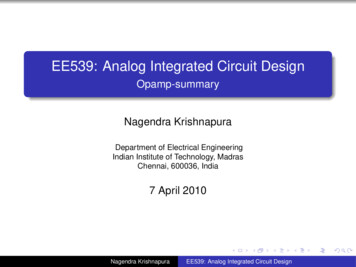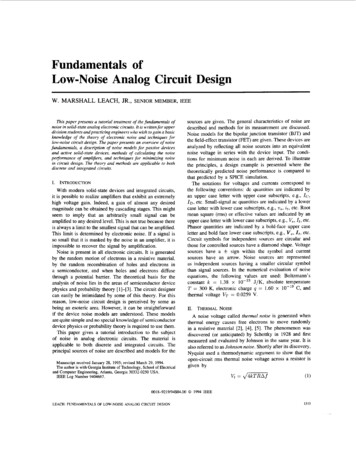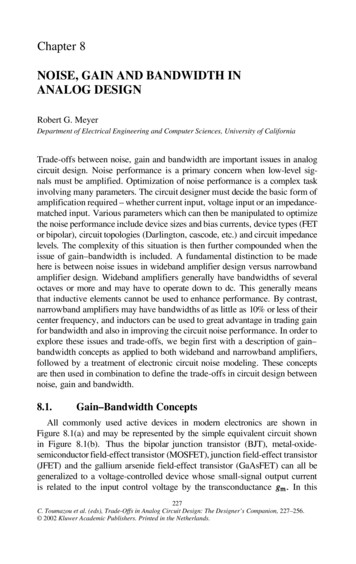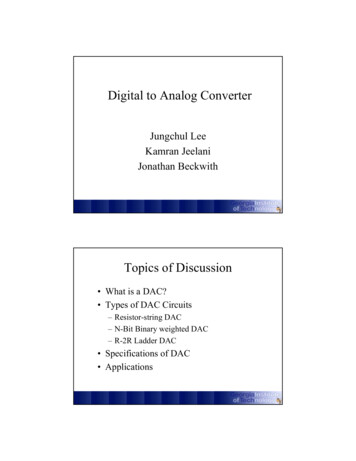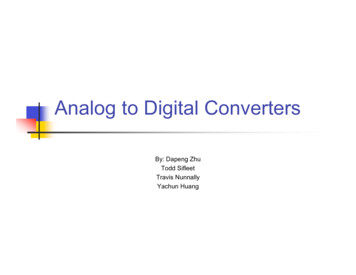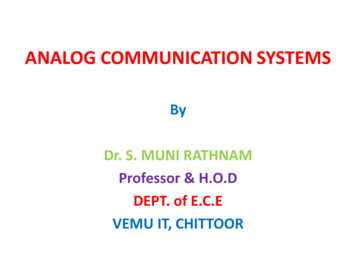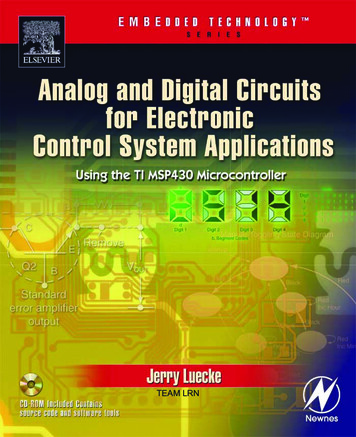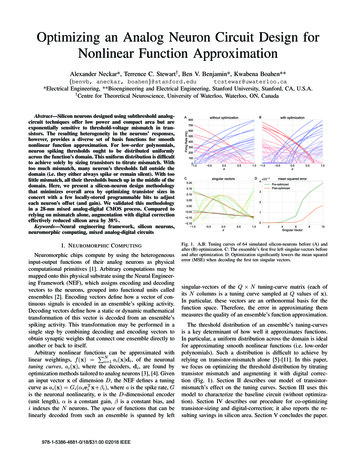
Transcription
EE 5211Analog Integrated Circuit DesignHua TangFall 2012
Today’s topic:1. Introduction to Analog IC2. IC Manufacturing (Chapter 2)
Introduction What is Integrated Circuit (IC) vs discretecircuits? Why?3
The Transistor RevolutionFirst BJT transistorBell Labs, 19484
The First Integrated CircuitBipolar logic1960’sECL 3-input GateMotorola 19665
Intel 4004 Micro-Processor19711000 transistors 1MHz operation10μm technology6
Intel Pentium (IV) microprocessor200142 Million transistors1.5 GHz operation0.18μm technology7
Intel Core 2 Duo Processor2006291 Million transistors3 GHz operation65nm technology8
More recent2007 800 Million transistors2 GHz operation45nm technology (the biggest change in CMOS transistortechnologies in 40 years)2011 2nd-generation Core i71.2 Billion transistors3.3 GHz operation32nm technology
Introduction What is Analog Integrated Circuit (IC) vsDigital Integrated Circuit?10
Analog versus Digital Information-bearing signals can be either analog or digital. Analog signal takes on a continuous range of amplitude values. Whereas digital signal takes on a finite set of discrete values (oftenbinary) and frequently changes values only at uniformly spacedpoints in time Analog circuits: circuits that connect to, create and manipulate arbitrary electricalsignals circuits that interface to the continuous-time “real” word11
So why do we still need analog? The real world is analog (voice, light, heart-beat ) Many of the inputs and outputs of electronic systems areanalog signal Many electronic systems, particularly those dealing with lowsignal amplitudes or very high frequency required analogapproach Lots of most challenging design problems are analog Good analog circuit designers are scarce (very wellcompensated, gain lots of respect, regarded as “artists”because of the “creative” circuit design they do )12
13
The dominance of digital circuits actually increased the amount of analog electronics inexistence. Nowdays, most electronic systems on a single chip contain both analog anddigital (called Mixed-signal SoC (System on Chip))From Texas Instruments
Basic semiconductor concepts A qualitative knowledge of semiconductor physics helps us understand the characteristicsof diodes and other devices discussed later. Several materials are most often used for fabrication of solid-state electronic devices:silicon (Si), germanium (Ge) and gallium arsenide (GaAs) Silicon is most used, therefore a focus is put on Si in the discussion.16
Intrinsic silicon Bohr model of an isolated silicon atom consists of a nucleus containing 14 protons. 14 electrons surround the nucleus in specific orbits (know as shells) The innermost shell (lowest energy) consists of 2 orbits. The next higher energy shellcontains 8 orbits. The remaining 4 electrons occupy the outmost shell (called valence shell). In intrinsic (pure) silicon, each atom takes up a lattice position having four neighboratoms. Each pair of neighboring atoms forms a covalent bond consisting of two electronsorbiting the pair.Figure 3.36 Intrinsic silicon crystal.17
Intrinsic silicon II At absolute zero temperature, electrons takes the lowest energy state available and allvalence electrons are bound in covalent bounds and are not free to move. (silicon is anelectrical insulator in this condition). However, in room temperatures (300K), a small fraction of the electrons gain sufficientthermal energy to break loose from the covalent bonds. These free electrons can easilymove through the crystal. If voltage is applied to intrinsic silicon,current flows. However, the number of freeelectrons is small compared to a goodconductor (so called semiconductor). Quantitatively, at room temperature only1.45e10 free electrons per cm 3 among5.0e22 atoms.Figure 3.37 Thermal energy can break a bond,creating a vacancy and a free electron,18both of which can move freely through the crystal.
Intrinsic silicon III: conduction by holes Free electrons are not the only means by which current flows in intrinsic silicon. Though it is the electrons that actually move, the vacancy or the hole can be thought of asa positive charge carrier that is free to move in the silicon. (bound electron can move only ifa vacancy exists nearby). In an intrinsic silicon, an equal number of holes and free electrons are available, or ni piwhere ni denotes the free electron concentration and pi hole concentration. When an electric field is applied to the intrinsic silicon, both types of carriers contribute tocurrent flow.Figure 3.38 As electrons move to the left to fill a hole, the hole moves to the right.19
N-type semiconductor Adding small amounts of suitable impurities to the crystal dramatically affects the relativeconcentration of holes and electrons. The resulting semiconductor is called extrinsicsemiconductor. A material of impurity, such as phosphorus, have 5 valence electrons. It forms covalentbonds with their four neighbors and the 5th is only weakly bound to the atom. At certain temperature, the 5th electron can easily breaks its bond with the atom andbecomes a free electron. However, a hole is not created by the impurity atom as the positivecharge that balances the free electron is locked in the ionic core of the atom (or no covalentbond vacancy) Impurities that does this is known as donors to silicon and the resulting material is calledN-type semiconductor material. In N-type material, conduction is mainly due to free electrons. Thus free electrons arecalled majority carriers and holes called minority carriers. Donor atoms giving up their 5th electron is said to become ionized. Positive charge isassociated with each ionized atom. Net charge concentration is zero, ie. positive charge of ionized donors and holes is equal tonegative charge of electrons.20
Figure 3.39 n-type silicon is created by adding valence five impurity atoms.21
P-type semiconductor In contrast to N-type semiconductor, impurity such as boron can be added to intrinsicsilicon to form P-type semiconductor. Each impurity atom forms covalent bonds with three of its neighbors, but it does not havethe 4th electron to complete the bond with the 4th neighbor. At usual operating temperatures, an electron from a nearby silicon atom moves in to fill thefourth bond of each impurity atom. This creates a hole moving freely through the crystal . Since the electron is bound to the ionized impurity atom, conduction in P-type material ismainly due to holes. Holes are called majority carriers and electrons minority carriers. The impurities are called acceptors because they accept an extra electron. Ionized impurity atom has negative charge. The concentration of holes is equal to the sumof concentration of free electrons and that of acceptor atoms.22
Figure 3.40 p-type silicon is created by adding valence three impurity atoms.23
Basic IC circuit component: MOS transistorMOS: Metal Oxide Semiconductor
Modern dual-well CMOS Processgate-oxideTiSi2AlCuSiO2Tungstenpolyp-welln p-epip p Dual-Well Trench-Isolated CMOS Process25SiO2n-well
CMOS Process at a GlanceDefine active areasEtch and fill trenchesImplant well regionsDeposit and patternpolysilicon layerImplant source and drainregions and substrate contactsCreate contact and via windowsDeposit and pattern metal layers26
CMOS Process Walk-Throughp-epi(a) Base material: p substratewith p-epi layerp Si N34p-epiSiO2(b) After deposition of gate-oxide andsacrificial nitride (acts as abuffer layer)p p 27(c) After plasma etch of insulatingtrenches using the inverse ofthe active area mask
CMOS Process Walk-ThroughSiO2(d) After trench filling, CMPplanarization, and removal ofsacrificial nitridenp28(e) After n-well andVadjust implantsTp(f) After p-well andVadjust implantsTn
CMOS Process Walk-Throughpoly(silicon)(g) After polysilicon depositionand etchPwelln Nwellp (h) After n source/drain andp source/drain implants. Thesesteps also dope the polysilicon.SiO2(i) After deposition of SiOinsulator and contact hole etch.29
CMOS Process Walk-ThroughAl(j) After deposition andpatterning of first Al layer.AlSiO2(k) After deposition of SiO2insulator, etching of via’s,deposition and patterning ofsecond layer of Al.30
Advanced Metallization31
Design Rules32
Design Rules Interface between designer and process engineer Guidelines for constructing process masks Unit dimension: Minimum length– scalable design rules: lambda parameter (SCMOSSUBMICRON Design Rules)Technology 2 lambda– absolute dimensions (micron rules)33
Layers in 0.25 mm CMOS process34
Intra-Layer Design RulesSame Potential0or6WellDifferent Potential29Polysilicon2103ActiveContactor ViaHole32Select3Metal12234Metal2335
Vias and Contacts24Via115Metal to1Active ContactMetal toPoly Contact322362
CMOS Inverter LayoutInGNDVD DAA’Out(a) LayoutAA’np-substraten (b) Cross-Section along A-A’37p FieldOxide
Layout Editor38
Design Rule Checkpoly not fet to all diff minimum spacing 0.14 um.
Feature sizeThe minimum feature size a CMOS process is roughly the minimum allowable value forL and W. For example, in a 5um process the minimum permissible value of L and Wwould be 5um.Feature size keeps scaling down in the past years, eg. 2um, 1um, 0.5um, 0.35um,0.25um, 0.18um, 0.13um, 90nm, 65nm, 45nm, 33nm, 23nm, .
analog signal Many electronic systems, particularly those dealing with low signal amplitudes or very high frequency required analog approach Lots of most challenging design problems are analog Good analog circuit designers are scarce (very well
